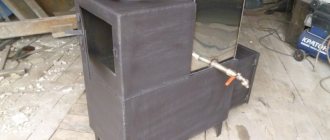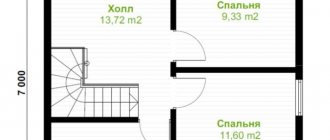Residents of apartment buildings often encounter a situation where an unpleasant odor appears from the ventilation. Instead of purification, supplying a fresh portion of air and removing waste air, the system becomes a cause of discomfort. Have you also encountered a similar problem - are you bothered by unpleasant odors from the ventilation and you don’t know how to deal with them?
We will help you solve the problem - in this material we will talk in detail about how to get rid of the smell in the ventilation, what preventive measures to take to ensure its uninterrupted operation. We will also supplement the article with thematic photos and useful video tips.
Natural ventilation
In the “realm” of plastic, problems arise with natural ventilation.
Apartment buildings that were built before and are being built now are equipped with natural ventilation. Fresh air enters the premises through natural cracks in windows and doors, and leaves the premises through ventilation openings in the sanitary and bathroom rooms and kitchen. This is how it should happen if it works properly.
But, unfortunately, for a number of reasons, ventilation stops functioning and air exchange is disrupted. In order to understand why a non-smoking apartment starts to smell like cigarettes, you need to know what types of ventilation exist.
The intake of fresh air naturally and the same removal of exhaust air through ventilation ducts is called natural ventilation. Despite its obvious advantage - simplicity, there are significant disadvantages:
- It works mainly in the cold season. This is due to the fact that air exchange occurs from the difference in temperature and atmospheric pressure outside and in the apartment. The larger it is, the more air enters the room, displacing the exhaust air.
- It is impossible to achieve constant air exchange.
- The air coming from the street is not cleaned of harmful impurities.
- The incoming air is not filtered from noise.
- Cooled air masses enter the room.
Linen closet
Getting rid of mustiness in your closet is very easy. First, you need to thoroughly wash all your clothes and put them away only after they are completely dry.
To prevent the smell from appearing again, you should not add anything worn to clean clothes, even once within half an hour. Worn items that remain clean for a long time will permeate the latter with different aromas, most likely unpleasant.
In addition, you can add a sachet to clothes that are stored for a long time and are rarely taken out - this is a special fragrance for linen. You can buy it in a store or make it yourself. To do this, a rag bag is sewn; the fabric must be natural - linen or cotton.
Suitable fillers include spices (cinnamon or cloves), dried herbs (melissa, mint, rosemary), dry citrus peels, and essential oils applied to cotton wool.
Forced ventilation
With supply and exhaust ventilation, the operating principle is based on process automation, which significantly improves its functionality.
In modern buildings, automatic ventilation is installed, solving problems with any foreign odors.
- There is constant air exchange.
- Air purified from dust and noise enters the apartment.
- There is no reverse draft, so odors from neighbors through the hood do not bother you.
- The air entering the room is heated by the air leaving it.
An example of such ventilation is a recuperator. But the disadvantages are expensive equipment and installation carried out by specialists. An important factor is energy dependence, which entails material costs.
Important! There is a system that does not require large material costs and allows you to solve some of the “punctures” of natural ventilation, improving its functionality. This is mixed ventilation (natural inflow and exhaust installation).
Where to complain and how to fight
If your neighbors stink, there are four authorities at your disposal to whom you can contact, complain and quickly solve your problem:
- The district police officer receives not only individual complaints, but also collective ones. If you are tormented by the smell of tobacco in your apartment, a stinking sewer, or the stench from your neighbors’ pets, contact your local police officer directly. It doesn’t matter where exactly the unpleasant aroma is coming from - from neighbors above or below.
- The prosecutor's office also accepts complaints from all categories of citizens, but it is better to make an appointment in advance.
- Rospotrebnadzor – this body is responsible for monitoring violations of sanitary and epidemiological standards. By law, the department must give the violator a warning indicating all existing shortcomings and provide time to eliminate them. In case of disobedience, the intractable neighbor can be evicted through the court, but only if the apartment is rented.
- Court. How else to radically get rid of a neighbor who is trampling on the rights and legitimate interests of other citizens, if not through eviction? The court is the last resort where they can help even in difficult situations.
Any problems can be solved. Don't panic and contact the competent authorities.
Causes of poor ventilation
In fact, there are not so many reasons why the ventilation system malfunctions. And the main thing is that most of them can be solved with small material and labor costs.
In addition to the main ventilation, additional channels can be installed
- One of the main reasons today why there is a smell from the ventilation in a residential building is a violation of natural air exchange. This happens due to the installed metal-plastic windows that do not let air in from the street.
- Contamination of the ventilation duct with soot, fatty deposits, bird residues, and construction waste.
- Violation of the ventilation duct by one of the neighbors.
- In winter, snow may clog into the ventilation duct, and due to temperature differences, it begins to melt and freeze again, forming ice.
- A kitchen hood that is too powerful can absorb not only the fumes and odors of cooking food, but also interrupt the natural “escape” of air saturated with carbon dioxide from the ventilation holes in the sanitary rooms. The kitchen hood does not release it, and even tries to suck the smell from the ventilation from the neighbors, forming a reverse draft.
- For residents of upper floors, a short (less than 6 meters) ventilation pipe may be a problem with ventilation. Its height does not allow the exhaust air from the entire riser to be “squeezed out” upward, and it finds a shorter path through the ventilation duct to those living on the top floor.
Clearing the blockage
If the problem is a clogged ventilation duct, then your actions depend on where exactly the problem is located:
- from the side of the apartment. More precisely, in that part of the ventilation duct that you can reach from your home. To remove the blockage you will need a metal brush. Cover everything under the vent with cloth or newspaper so you don't have to wash off dirt from furniture or fixtures later. Then remove the grate that protects the entrance to the channel. If it has clearly outlived its usefulness, throw it away, then install a new one. If the grate itself is in order, then thoroughly wash it from dirt using a hard sponge and dishwashing detergent. Then, using a metal brush, scrape off the layer of dirt from the walls of the ventilation duct. If you find large debris there, pull it out with your hands or tongs. Remove everything that has been scraped off from the canal using a vacuum cleaner. After this, you can return the grille to its rightful place,
- from the roof side. If the blockage is located somewhere deep, then the question of how to get rid of it is not before you personally. Roof work is the prerogative of specialists. Contact the management company about this. They should send specialists from there who will quickly and safely remove the blockage.
Important! Even if you are completely confident in your abilities, do not climb onto the roof. You may fall from it if exposed to strong gusts of wind.
You may stumble upon a wasp's nest built in a ventilation duct - and its inhabitants will definitely not be happy with you, which they will express very actively. Finally, by doing the wrong thing, you can damage the ventilation duct, and you will have to answer for it. In general, leave this work to those who are paid to do it.
Eliminating odor from kitchen ventilation
Today's market can offer the consumer several options for solving problems with reverse thrust. One of them would be to install an exhaust fan in the kitchen.
If general ventilation cannot cope in the kitchen, it is worth installing an additional fan
Before purchasing a device, you need to find out the required power. It is calculated by multiplying the volume of the kitchen by the air exchange rate. According to sanitary standards for kitchens with an area of 8 to 18 square meters. m, the air exchange rate is 6-12.
P = V x Kvo, where
V = S x h, room volume, cubic meters. m;
S – room area, sq. m;
h – room height, m;
Kvo – air exchange rate per hour
P – required power, cubic meters. m/h, for the kitchen - from 100 to 320 cubic meters. m/h.
When choosing a fan, pay attention to the presence of a protective insect net; easy to remove the front panel to clean the case; blades from adhering fat. You can install the exhaust fan on the wall yourself.
- Prepare a through hole in the outer wall of the house.
- Remove the lid and the exhaust ventilation grille, through which unpleasant odors will escape.
- Apply the adhesive solution to the engine installation area.
- Install the device and hold it for several minutes, pressing until the surfaces “grab.”
- Connect to the mains.
- Install a mosquito net and decorative cover.
- Attach an exhaust ventilation grille to the front side.
Important! The fan design must contain a check valve. It will hold back cold air masses from the street when the fan is on.
We solve the problem with the help of a hood
Not every device you like in terms of design is suitable for a particular room. It is important to choose equipment that will perform its functions 100%.
Power calculation
This parameter for an apartment can be calculated using the formula: area × ceiling height × 12, where 12 is the established rate of air renewal in the kitchen in 1 hour.
Installation
If you follow the instructions correctly, you can install the hood yourself.
- Start with the anti-return valve. Place it in front of the ventilation shaft, this will prevent air from flowing back.
- Place the device body above the stove. If there is a cabinet hanging above it, make the necessary markings on it. Don't forget about the hole for the air duct inside the hanging box.
- To connect the hood later, you need to install the corrugation and pull it through the slots in the cabinet.
- Hang the furniture above the stove and seal the corrugated joints with sealant to avoid loss of power.
- Install and secure the hood. This can be done by screwing the structure onto self-tapping screws.
- Connect the corrugation to the ventilation channel and secure it.
- If you connect the device directly, then simply connect the air duct to the ventilation.
Important: do not forget to clean the hood from time to time to protect your place of residence from short circuits. This may occur as a result of fat getting inside the device.
Ventilation in sanitary rooms
When a smell from the ventilation in the toilet enters the apartment, what should you do? This problem can be solved using an exhaust fan. This fan has a slightly different design than the one in the kitchen. It must be installed in an existing ventilation duct, instead of a ventilation grille. It has a simple design and easy installation.
Fan on the ventilation duct in the bathroom
For the toilet, it is better to choose a fan with a timer. It will allow you to remove unpleasant odors for some time after you leave it. The timer may not turn off the fan for almost half an hour. Like others, forced exhaust for a toilet is chosen based on power.
So, for toilet rooms with S = 2-8 sq. m, with an air exchange rate of 6 to 8 units per hour, similar power calculations are made as for a kitchen fan. The required power of such a device varies between 90-190 cubic meters. m/h.
Folk remedies
Let's talk about how to remove the grave smell from your home using folk methods. What to do if it appears? Traditional methods include all food and household products that housewives use almost every day. In most cases, these are the same products that are used in other cases when it comes to bad odors that would like to smell good.
A combination of coal and salt can be considered a good way to absorb moisture. Recipe: Mix 2-3 packs of activated carbon with 100 grams of table salt. Charcoal can be ground into powder for an aesthetically pleasing appearance. Also, the charcoal does not have to be activated, but regular charcoal, prepared for the barbecue, is also suitable. The mixture described above can be placed in a beautiful vase or glass and used as a decorative element, while the chemical elements will do their job. The contents of the glass should be replaced once a week.
You can also use a product called pomanders. This is a combination of oranges and cloves. Instead of orange, you can also take lemon or grapefruit, stick cloves into the peel and you're done. This “decoration” of a room can serve its purpose within 2 months. And with the help of such minor means we get rid of unnecessary odors.
Window valves
You can combat the fact that the smell of sewage enters the apartment from the ventilation system not only by installing exhaust devices. Along with it, it is recommended to install supply valves on metal-plastic windows.
Window valve
The influx of fresh air, replacing the exhaust air that was removed by installed fans, can only fully come from outside. Windows are considered an excellent source of this supply. But given that the windows are sealed, air enters through the front door, that is, from the staircase. And this, in principle, is the same smell from the ventilation in the bathroom or toilet. That’s why Air Box Comfort ventilation valves are installed. Their advantage is that they are suitable for all profiles; do not affect the closing/opening of the window; do not require drilling of the profile, which violates the tightness of the window; presence of an air regulator.
Molds
If there is a damp smell in the room, it means there is mold lurking somewhere. As a rule, it occurs in the bathroom, toilet or kitchen, as well as in places where there is standing water, for example, near a cat's water bowl. Fortunately, there are many effective folk recipes that help remove the cause of dampness:
- activated carbon - it not only perfectly absorbs, but also disinfects the air; just grind 20 tablets into powder and put them in containers and place them in places where dampness has appeared;
- vinegar and essential oils - add essential oils and 2 tablespoons of vinegar to a bucket of water (1 liter), use the solution to wash floors and walls at least once a week;
- coffee - coffee beans are a good help against the smell of dampness; place stacks of beans in the bathroom or bathroom for a week, and then replace them with new ones;
- rock salt - pour it into a glass, place it in a damp place and change it as needed. This product perfectly absorbs excess moisture.
It smells damp where it is humid and warm, so it is these factors that must be combated. You should not dry towels in the bathroom for a long time. Wash and dry the rags you use to clean your apartment. Do not close the washing machine door when the washing is not running: let the excess moisture evaporate from it. Do not keep the doors in the bathroom and toilet closed all the time; if they have windows, ventilate the rooms more often. Turn on a fan or ventilate the bathroom after every shower. If you follow these rules, high humidity will drop to normal levels and there will be no dampness.
Easy installation in minutes
- Mark the length of the valve on the window sash.
- Cut off the seal in this place.
- Insert the seal supplied with the valve.
- Remove the protective film from the valve.
- Install the valve onto the sash using the screws included in the kit.
- After closing the window, mark the exact location of the valve relative to the frame.
- Cut off the installed seal and install another one.
Partial replacement of the standard seal with narrower sections allows fresh air to enter the room. This device will not be able to completely correct problems in the ventilation system, but will become a barrier to various odors from the ventilation.
Oil burner
An aroma lamp will help solve the problem. It can be purchased at a hardware store. The lamp consists of a container for water and a device for a small candle.
- Ventilate the room before using the device. Once ventilation is complete, close all windows.
- Prepare the aroma lamp. Pour a small amount of water into the device’s special container and add a few drops of any aromatic oil. In order for the aroma to be more intense, it is better to use regular salt instead of water.
- Place a burning candle under the container. After a few minutes, the water with essential oils will begin to slowly evaporate, filling the room with a subtle aroma. Water can be added to the bowl in small portions.
After the procedure, put out the candle, pour out the water and wash the container well with soap so that not a drop of essential oil remains in it. An aromatherapy procedure will improve your mood and relieve the smell of cigarette smoke.











